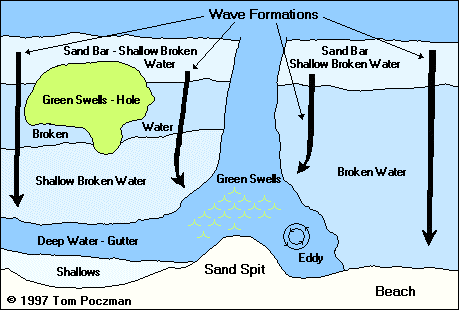Reading Beaches
One of the most difficult concepts to understand when it comes to beach fishing is the understanding of beach formations, how they impact and effect the movement of fish. I am by no means an expert in reading beaches, but I am aware of the rudimentary details and terminology involved in reading and discussing beaches, as well as identifying potential good spots on the beach.
 |
| Beach Formation A diagram of a common beach formation showing the characteristics indicative of landing a big fish such as a Mulloway. |
A beach that is uniform will offer little as far as expectations of fish catches. A beach which offers little sand movement will therefore offer little in the way of food being uncovered on which the fish can feed. If any fish do happen to visit the area, they will only stay for a short period of time.
Another condition which is often unfavourable to fish is a beach pounded by dumping surf over its total length. Very few fish will enter these water conditions, preferring instead to wait out beyond the surf for any food which may be taken away by the receding waters.
When reading a beach, the presence of an area of green swells in between broken water is a tell-tale sign of the presence of water which is deeper than the surrounding area. It is these observations which will tell the fisherman of formations or deformations of the beach, such as a hole, a gutter or a channel. If you watch the passage of the swells, you could soon figure out the areas of deep water, as well as the length of the deep water and whether or not it extends out beyond the surf zone.
Should you come across a hole, and if it's situated well into the surf, it is normally referred to as a low-tide hole. The reverse applies to a high-tide hole, it's closer into the beach. Hence, low-tide holes can be fished on the beginning of a rising tide and the bottom of a falling tide.
Another thing to look out for is the presence of sea birds, for their behaviour can tell you a great deal about fish movement and the areas of bait fish. Birds often rely on the predatory fish to chase the bait fish to the surface. So there is a good reason for seabirds to gather over mobs of bait fish which are being hit from below by predators.
When there is no feeding frenzy, birds usually climb to a higher altitude, hover and scan the ocean. From this height they can watch the shimmering schools of bait fish or the darker patches of schooling predators in the water. The altitude of the sea bird above the water is a good indicator of the depth at which the fish are swimming. The closer the schools of fish are to the surface, the lower the birds hover, and vice versa.
Some types of birds are more reliable than others as indicators of the presence of fish. Seagulls are at the bottom of the scale where as terns and petrels are at the top of the reliability scale. Seagulls will go for just about anything, as they are the ultimate scavenger of the sea. While terns on the other hand prefer live food and hunt the same types of fish that attract predators.
So, by looking at the behaviour of the sea birds out on the water, as well as reading a beach correctly, this should offer you the best chance in hauling in a good day's catch of fish.
Glossary
Hole:
A deep area of water and in most cases can be found on or adjacent to a sandbar.
Gutter:
A narrow corridor of water which is deeper than the surrounding area and usually runs parallel to the shore line and wave formations. Gutters usually act as a draining area for water heights above what a bar can handle.
Bar:
An area of shallow water formed by sand. This area is shallower than any other formation on the beach, and is, under normal surf conditions, covered by broken waves at all times thru out the tides.
Spit:
An area of sand or bar which extends further into the sea than the normal beach shore line. Often, a spit will be accompanied by a corresponding spit, which is formed well out from the beach and extends back towards the shore line or beach. Water travels faster on the run side of the spit and between the spits themselves, but tends to back off or form an eddy on the leeward (in the direction towards which the wind blows) side.
Outcrop:
A formation of rock in much the same manner as a spit will often be the only variation to an otherwise straight or curving beach line. These areas can often give great fishing results.
Channel:
A deep area of water, often very close to the beach, which extends far out beyond the sand bar. These channels carry the big volume of spillage from the bars and gutters and are a prime area for big fish. They also enable baits and lines to reach distances from the beach which could never be achieved by normal casting.
Foul Ground:
An area of reef either in or just beyond the surf zone. This area can have a strong influence on where fish are and will often allow for easy fishing when all other areas are a washout because of big seas or strong wind conditions.
Wave Formations:
A name given to the shape and condition of the swells approaching the beach. Their different characteristics are an indication of the presence of just about all the other formations mentioned.
Eddy:
A current of water moving with a circular motion against the main current.
 Fishing Tip : Fishing Tip : |
|
| Why not contact fishSA.com about your Fishing Tip |
|
|